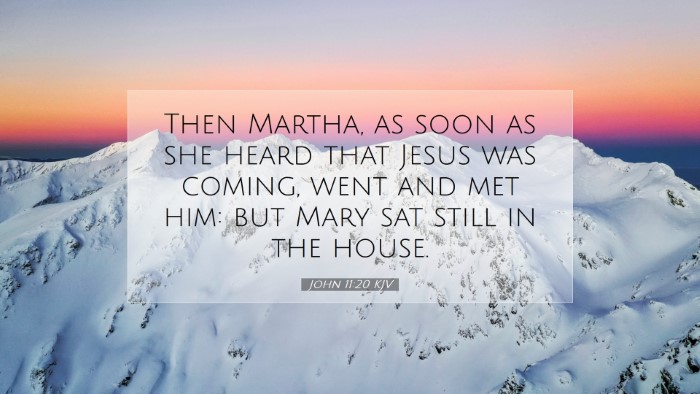Commentary on John 11:20
In John 11:20, we see a pivotal moment in the Gospel narrative where the emotional and theological implications surrounding the death of Lazarus are brought to the forefront. This verse states, “Then Martha, as soon as she heard that Jesus was coming, went and met him: but Mary sat still in the house.” Below, we explore various insights drawn from esteemed public domain commentaries, providing a rich tapestry of theological understanding.
Contextual Background
John 11 recounts the death and resurrection of Lazarus, one of Jesus' closest friends, and highlights the different reactions of Martha and Mary, two sisters deeply affected by their brother’s death. This episode is not just a narrative of grief; it demonstrates Jesus' humanity, divinity, and power over death.
Martha's Response
Martha's immediate action upon hearing of Jesus' arrival is significant. It illustrates her active faith and readiness to confront Jesus, as noted by Matthew Henry:
“Martha was quick to go to Jesus; her faith urged her to meet Him, indicative of her desire for understanding and reconciliation.”
This impulse reflects her character—a practical, action-oriented individual, as portrayed in previous interactions with Jesus. In contrast, Mary remains in the house, perhaps overwhelmed by grief, which Albert Barnes points out as:
“Mary’s choice to stay behind may reflect a more contemplative nature, highlighting the different ways individuals process grief.”
Symbolism in Meeting Jesus
When Martha hears of Jesus' coming, her decision to meet Him represents more than physical movement; it symbolizes the pursuit of truth and hope amidst despair. Adam Clarke states:
“Martha’s movement toward Jesus can be seen as a search for answers, embodying the struggle between faith and doubt.”
This illustrates a vital truth about human nature—we often seek Jesus desperately when we confront our most challenging circumstances.
Theological Implications
The theological richness of this verse lies in the implications of Jesus' arrival. He is not merely a healer; He embodies life itself. Here, we begin to see the foreshadowing of the resurrection not only of Lazarus but also of the ultimate resurrection that believers await through Christ. Matthew Henry remarks:
“The Lord’s coming is timely, even when it appears delayed; His presence inevitably brings hope.”
Comparative Analysis: Martha vs. Mary
The contrasting actions of Martha and Mary in this passage highlight distinct responses to Jesus' ministry and presence. Martha's initiative juxtaposes with Mary’s stillness, prompting reflections on worship, expression of grief, and faith:
- Martha: Represents proactive faith, seeking dialogue and understanding with Jesus.
- Mary: Embodies contemplative faith, often characterized by emotional surrender to God’s will.
Albert Barnes emphasizes the importance of both responses:
“Both approaches are valid in their own contexts; faith can be expressed both verbally and through quieter contemplation.”
Application for Believers
For pastors and theologians, John 11:20 serves as an impetus to explore pastoral care and emotional support in times of grief. The varied responses of Martha and Mary invite reflection on how differently individuals may approach hardship and divine interactions. Here are some applications:
- Encouragement for Active Faith: Encourage congregants to actively seek Jesus in all circumstances, demonstrating the importance of engaging with faith.
- Understanding Grief: Recognize and validate the diverse expressions of grief within spiritual communities, acknowledging both action and inaction.
- Hope in Christ: Remind believers that Christ brings hope and life, even in situations that seem final, echoing the core message of resurrection and eternal life.
Conclusion
John 11:20 captures a moment of profound significance in the Gospel narrative, revealing not only the pain of mourning the loss of Lazarus but also the hope embodied in Christ’s impending arrival. The insights from public domain commentaries enrich our understanding of Martha and Mary's responses and how this passage invites believers into deeper engagement with their faith amidst life's challenges.


